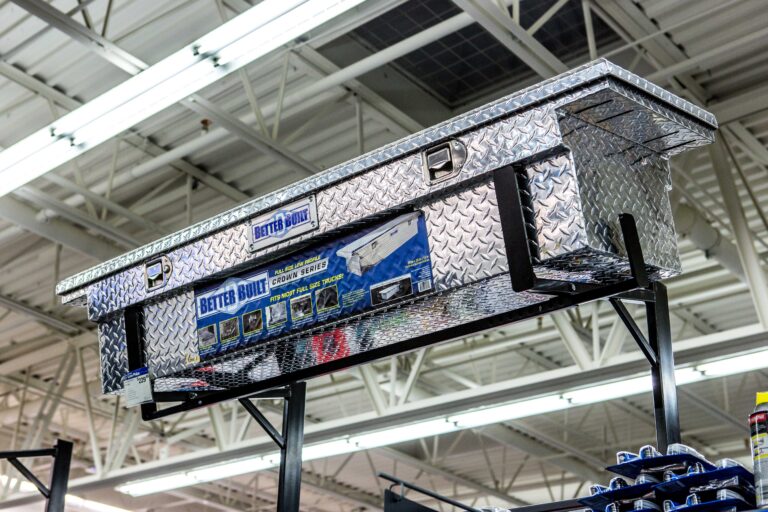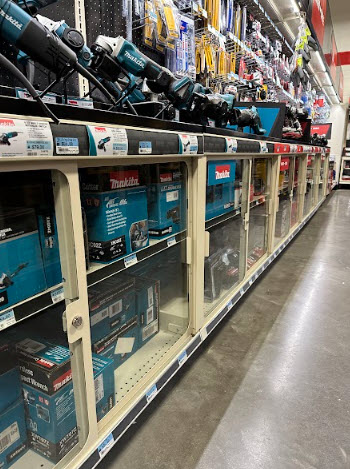Security cases are a versatile option for retailers beyond theft prevention. They can hold just about anything — from antiperspirants to Zippo® lighters and everything in between. Along with this versatility, they are becoming more and more critical in light of rising retail theft.
In this blog, we’ll dig into the components of security cases to help you get a sense of the options available and the advantages of each one.
We’ll take a look at the five main factors that go into security case design and the key questions to answer that will help you identify the right combination of features to choose for your purposes.
Security cases help deter theft
The increasing frequency of retail theft is bad news for retailers, and no part of the country is immune. In 2021, retail theft losses amounted to $94.5 billion, and Capital One Shopping research indicates that the dollar value of retail theft losses has increased 47% from 2019 to 2020. This trend is challenging retailers everywhere.
The good news is that custom security cases are a solid investment in deterring theft. “They pay for themselves very quickly, and [in comparison to the cost of the losses they prevent from goods stolen] they’re not very costly,” says Larry Johnson, L.A. Darling Engineering Manager.
Here are some key questions to ask in assessing the type of security case that’s right for you, as well as an overview of the variables that will drive your decision.
Assessing your needs
Let’s start with some basic questions that will guide the process of selecting the right design options for your application.
What do you want to protect?
Case design will be affected by the physical size of the items the case will store as well as their value. For example, interior shelves adjust to accommodate anything from small items to larger, heavier ones. And the dimensions of the goods stored will affect the choice of door operation, as swinging doors open wide for full access while sliding doors only give access to half the case width at a time.
Where will the case be located?
Will it be customer-facing or used for storage in a backroom or to hold extra stock behind the counter? Glass cases offer the best visibility for customers. Woven wire or shark cage case doors may be suitable on the sales floor or in the backroom, depending on your needs.
What level of security do you seek to maintain, and at what cost?
High value items usually warrant more robust security cases and electronic locking systems offer more control at a correspondingly higher cost.
These 5 key variables drive security case design decisions
Equipped with your answers to these questions, let’s take a closer look at each of the five design parameters that shape the construction of L.A. Darling’s security display cases.
- Case dimensions and installation
- Door material
- Door construction and operation
- Appearance and finish
- Locking mechanisms and access control

Customization is virtually unlimited and is driven by the needs and applications of the individual customer.
1. Case dimensions and installation
Typically a single case is sized 3’ or 4’ wide by about 30” high and is designed to fit on a gondola. Frequently, individual cases are connected into runs that can stretch 40, 50 or up to 60 feet, having solid panels on each end, and each case having its own set of locking doors.
Most often, security cases are installed on the gondola base, but other design options are possible, including a stacked arrangement. They can also be located on end caps.

Free-standing or standalone cases may be constructed for a single display. For security, they are often anchored to a wall or the floor or integrated into another display.
Strong security cases can also be constructed on wheels to become mobile. For example, during the pandemic, secure cases were used for curbside pick-up of high value consumer products from a big box retailer.
Maximum dimensions for freestanding cases are largely determined by the material used for the front of the cases: glass, woven wire, or solid metal. Glass panels are generally limited to a maximum of 76” in height.

Some retailers use security cases for overhead storage to hold stock on the sales floor above product display shelving. While not suited to all stores, Johnson expects to see this application increase in the future.

2. Door material
Security case doors can be designed to offer both visibility and security.
Customer-facing operations may put a priority on allowing customers to see into the cases while backroom storage or stock that is under employee control may need storage that emphasizes security over visibility.
Typical materials used by L.A. Darling are listed below in order of increasing levels of security and robustness.
Plexiglass/polycarbonate/acrylic. These materials offer the positive attributes of clear visibility and low cost while providing a basic level of security. But these materials have one main disadvantage: when they break, they don’t make as much noise as breaking glass.
Noise is itself part of the overall deterrent strategy, helping to attract the attention of the security team or staff for a rapid response.
Tempered glass. Sturdy, simple, tempered glass is widely used in security case doors. When broken, it shatters noisily into loads of tiny pieces, creating a loud disruption that attracts attention of store and security personnel.
Depending on the case structural design, glass door panels may have metal trim edges if a hinged door design is selected. Tempered glass is the most widely used option in cases with sliding glass doors.

Armored glass. Formed with wire mesh inside the glass itself, armored glass creates a product that is very hard to break, yet allowing visibility of the items inside the case.
Shark cage or woven wire. This high-security option does not use glass. Instead, display case doors are constructed of ¼” thick steel wires woven together into a 2-inch grid pattern.

“The resulting surface prevents anyone from reaching their hands into the case through the door, and the wires are difficult for thieves to cut,” says Johnson. Visibility is somewhat reduced as compared to a glass front case. With no glass to break and make noise, the sides and front of the case are made more beefy to increase security.
Solid metal. For some applications, it’s best to offer no visibility of the product at all to customers unless under the supervision of store personnel. Solid metal doors also provide a secure option for storage of extra stock.
3. Door construction and operation
The door configuration you choose for your security cases will depend on dimensions of what the cases will hold as well as available space in the aisle or around the case.
Sliding bypass doors. One of the most popular options is to configure cases with sliding glass bypass doors. The glass provides an easy view for customers, and the sliding doors conserve space in the aisle.
A potential drawback could be the fact that only one half of the case at a time is fully accessible, making it more difficult to use for larger items. Bypass doors are available for glass, woven wire, or metal.
Hinged doors. Center opening doors, hinged on the left and right, provide easy access to the full interior space, so restocking is easy. Because the doors open outward, extra space is needed for the doors to swing out–this could be problematic in tight areas or where aisle space is limited.

A wardrobe style mechanism of interlocking vertical bars is installed on hinged doors to prevent them from being pried open when locked. Swinging doors are available for glass, woven wire, or metal.
Roll-up garage door. Especially in backroom storage areas, these metal slatted doors roll up and down and can be locked to conceal stored goods. They also can be made in larger dimensions to secure wider areas, usually in the backroom.
4. Appearance and finish
Security cases can be completely customized, inside and out, for function and appearance.
Inside the cases, adjustable shelving can be installed at one-inch increments to create any type of display that’s desired. In order to allow for movement of sliding doors, most often the shelves have a depth that is about 2” less than the full depth of the cabinet.
The sides, bottom, top, and back of all security displays made by L.A. Darling are solid steel, as are interior rails.
The entire case body is powder coated; you can choose from the full range of hundreds of RAL industry standard colors and finishes to meet your brand and aesthetic requirements. Choose a shiny or dull finish and color to match your brand identity and blend in or make a statement with a clear contrast.
5. Locking mechanisms and access control
In the broadest terms, the locking mechanisms are typically either manual or electronic.
Users have a range of locks and operational mechanisms to choose from that are compatible with L.A. Darling custom security cases and the needs of their retail organization.

Manual locking mechanisms include cam, plunger-style, and ratchet locks. With a strong reputation throughout the industry, Kenstan locks are highly respected and very popular for many applications. “Duplication of keys is next to impossible with these systems and Kenstan designed a specialized locking system exclusively for L.A. Darling security cases,” says Johnson.
Moving up in price, as well as versatility of control, electronic locks are effective deterrents and are especially useful in reducing internal theft. “It’s a fact that a lot of people don’t understand, that internal theft is sometimes more prominent than theft from outside,” says Johnson, and electronic locking systems offer an effective means of control.
A single fob can be programmed to operate many locks, for a manager or department head, or it can have restricted access for sales personnel. What’s more, electronic locks can be disabled easily as well when someone leaves employment. Increased oversight and sophisticated technology involved in electronic locking systems make them more costly than mechanical systems, an expense that may be justified by the value of the items secured.
Customized solutions tailored to your application
While the number of case design combinations may appear daunting, simplify the approach by returning to foundational questions: What’s the value of what’s inside? What do you want to lock up?
“The key thing behind the cases is to eliminate shrinkage. To reduce or completely eliminate shrinkage,” says Johnson. Customers “immediately get a return in reduced shrinkage.”
L.A. Darling produces solutions completely customized to the needs of your retail operation, your customers, your products, and your brand. Locked cases are versatile for use in many different parts of a store, with a huge range in potential for effective locking mechanisms. Talk to us about your current needs or take a look at our case study to see how we’ve used case design to help Walmart reduce retail shrink.